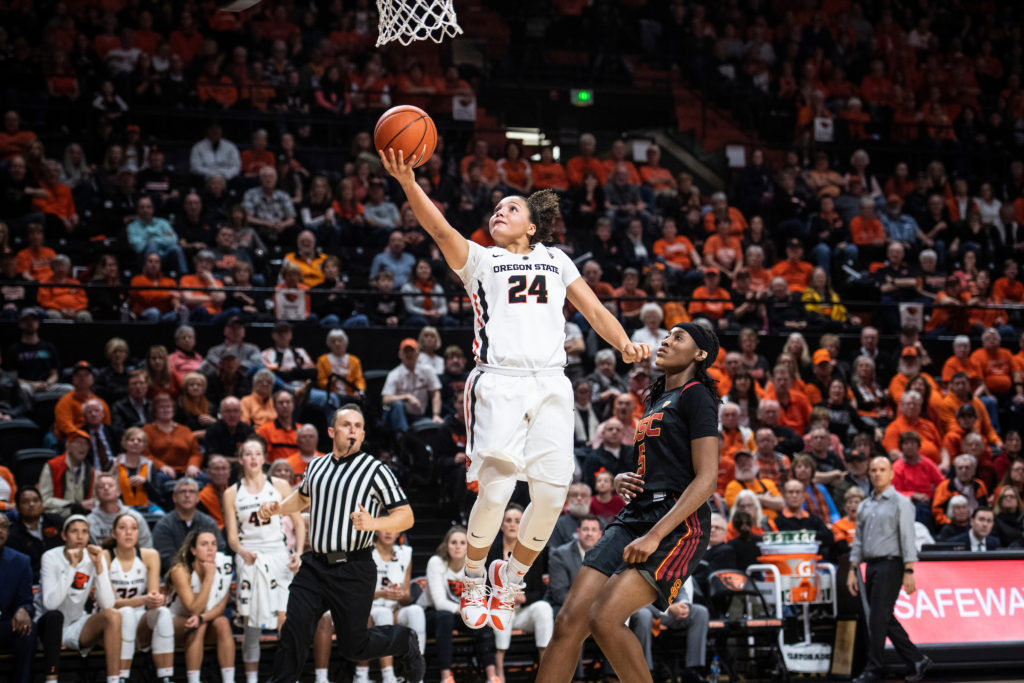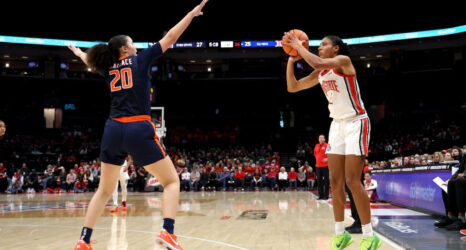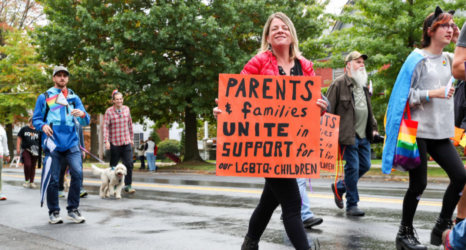It’s my favorite time of the year: NCAA women’s basketball tournament season, not to be confused with March Madness.
That moniker belongs only to the men’s playoff. The women’s tournament doesn’t have a spiffy name, or televised coverage of games in their entirety. Instead, for the first two rounds fans are often treated to a “whip-around” that shows bit and pieces of games, but ensures you rarely get to watch your favorite teams play one in full.
Network programmers apparently can’t imagine that viewers might actually want to watch the women of South Dakota State play Rice, even though the men’s teams from those two schools playing would be televised in its entirety.

In 2019, all 67 men’s tournament games will be televised on CBS, TBS, TruTV and TNT. The first 32 women’s games, by comparison, have only nine time slots on ESPN2, and the second round of 16 have only eight. Women’s games are also only televised once teams reach the Sweet 16.
I first played basketball as a fifth grader in Georgia—before Title IX, the legislation that called for gender equity in education, was in place. I didn’t have a coach; I had somebody’s mom who wanted to give girls a chance to play basketball. She was well meaning, but untrained, and she wasn’t able to offer us 10-year-olds a lot of help in basics like dribbling and passing.
Initially, we played a modified form of the half-court basketball girls had been forced to learn, under the assumption that we couldn’t actually run the whole court. (There were six players on each team—two guards, two forwards and two rovers—who did actually play full court.)
During my first year of high school, however, Georgia schools went to full-court basketball for girls. The girls from the other elementary school that fed our high school had had a real coach—a woman who had played basketball herself. Those girls were good: they knew how to dribble and how to pass.
I didn’t make the team that year. But I still loved the game. And across the next 40 years, I watched the sport change as Title IX took hold and the women’s movement challenged the strictures of gender that penalized girls if they were too strong, too fast, too tall or too smart.
Title IX meant schools and colleges had to treat women’s teams equitably. That meant equitable salaries for coaches, equitable scholarships and facilities, equitable training and resources. That meant a revolution in women’s basketball.
That revolution is still underway, and there remains works to do. The Institute for Diversity and Ethics in Sport’s 2018 Racial and Gender Report Card gave the NCAA a grade of C+ in its gender hiring. Only about 44 percent of all Division I, II and III athletes were women, and women held only 40 percent of Division I head coaching jobs for women’s sports. (In women’s basketball, women were almost 60 percent of head coaches.) In Division I schools, women were only 10.5 percent of athletic directors and 13 percent of sports information directors.
Some changes, however, have come to pass. If you haven’t watched a Top 25 NCAA Division I women’s basketball matchup in recent years, I can promise you this: It’s not your mother’s basketball.
These women are strong, fast and competitive. Some can dunk, but coaches usually frown on that; the finesse of the three-pointer swishing through the net is what energizes women’s basketball crowds. Today, women are tough under the boards, and they’re big. (I recently found myself wondering aloud if a 6’3” player was too short to play the post!)
Nine years ago, the brand new coach here at Oregon State University had to hold open try-outs after most of the previous team quit following a disastrous season. When Scott Rueck arrived, most of us just hoped we’d start to win a few games. Six years later, he led our women’s basketball team to the Final Four, and we finished the 2015/16 season ranked second in the country. We made the Sweet 16 again in 2017 and the Elite Eight in 2018. Now, it’s tournament time again.
We’re ranked #11 going into this year’s tournament, but this Oregon State team has done more than win—they’ve transformed a community into avid fans.
For the past three years, Oregon State led the Pac-12 in attendance at home games. About 5,000 people show up for each home game in a town of 55,000 people, and we’re second this year to the university just down the road, who’ve had their own women’s basketball renaissance in the past few years.
Title IX empowered NCAA women players to dream of playing professionally, but that’s not why most women play. Even if they go on to the WNBA, they won’t become millionaires like their NBA peers.
The starting salary for most WNBA rookies last year was just over $41,000, and the average salary for WNBA players is $79,000, whereas the NBA minimum salary is more than $800,000. The WNBA’s 2017 MVP earned $109,000, but the NBA’s 2017 MVP earned $28.5 million. While the women’s teams play fewer games and generate less revenue, the 2016 WNBA MVP was still underpaid by nearly $900,000.
A’ja Wilson, South Carolina’s unanimous 2018 National Player of the Year, earned just over $52,000 as the top draft pick. While University of Oregon junior Sabrina Ionescu would likely be the No. 1 pick in 2019, she would make less than 10 percent of the starting salary of the lowest drafted NBA player, despite the fact that she holds the NCAA triple-double record for both women’s and men’s basketball.
Yet this season, when Oregon State and the University of Oregon played back-to-back home-and-home games, Gill Coliseum and Knight Arena both sold out, and research suggests that people who attend one women’s basketball game are likely to attend more games in the future.
We’ve all heard that women’s basketball just isn’t as good as men’s, or just not as exciting. While it’s true that women’s basketball is a different game, it’s patriarchy that leads us to evaluate it as a lesser version of the “real” men’s version.
We are taught to value characteristics that more closely align with men’s bodies and sports that are constructed to highlight characteristics like speed, strength and musculature—such as football, baseball and basketball. We devalue sports that rely on physical characteristics more typically associated with women’s bodies—such as balance beam in gymnastics. When women play a sport constructed for male bodies, we then assume they must play a lesser, rather than different but equally athletic, version of the game.
Of course, this ranking system is maintained by male dominance over sport management and media. Men decide what sports will be played and when and which will be televised in what markets at what hours. What we see when we watch athletic events is shaped not only by the game itself, but also by the men who make decisions about the visibility and economic value of sports.
Simply by playing, women players resist gendered notions of strength and skill—and they know their own value, even if men with economic power don’t. They refuse definitions of themselves or their game as lesser.
So do their fans. In many ways, simply playing and watching women’s basketball are acts of resistance to patriarchy.
In Corvallis, we are Beaver Believers. Our team has built a relationship with fans that is at once intimate and fierce. Gill Coliseum is a rocking place to play women’s basketball. Oregon State has a home record of 76-8 since the start of the 2014-15 season. Sometimes, I’d swear the fans will our team to win in close games.
A kind of community gets built among fans that gives me hope. We have season tickets and have sat near the same people for years now. Were it not for basketball, we probably never would have known most of these people. Now we’re all basketball buddies.
During those two hours of play, we transcend many of the issues that divide us and the whole country right now. For a while, we’re not different from one another. We’re Beavers. In that space, we also seem to learn to make room for one another in our hearts, even across our differences. That may not change structures of oppression—that’s work for the other hours of the day—but it does connect us to one another in ways that can cause us to see differences differently. And that’s a start.
Certainly we face all the problems of big time college athletics in a Power 5 conference. Deficits, injuries, lack of parity—these all are also part of college sports, not to mention the scandals of late within so many elite athletic programs. Even my own memories of women’s basketball are tempered by my awareness of gendered expectations and pressures put on student athletes—schedules that can pit practice, weight-training and travel to games against academics, excessive spending and conflicting priorities.
Sociologists Cheryl Cooky and Michael Messner point to these complexities and contradictions as “the unevenness of social change.” Change and continuity in gender in/equality happen simultaneously, they explain. Still, when we come to March, I’m watching the rankings, following the bracketology, reserving my tournament tickets.
As with everything women do that challenges dominant norms, women’s college basketball is complicated. It can be both liberating and oppressive at the same time.
For the next few weeks, strong and skilled women will take to the court and will play hard and well. They’ll remind us of the progress we’ve made and the distance we still have to go, on the court and in all of society.
And I’ll be wearing my orange and black, cheering them on, cheering for all of us who resist.





